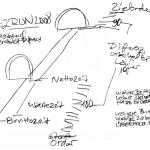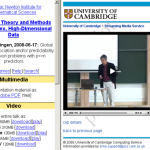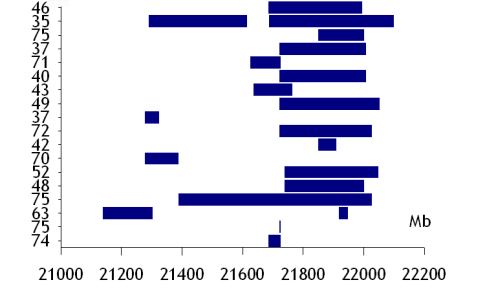Having been asked now by several people, I am compiling here a list of programs can be used for CNV calling. Continue reading CNV (not London) calling
The unoffical list of the most underrated companies in Munich
 The recent Munich city run B2Run offers some interesting (and largely accidential) insights into company philosophies.
The recent Munich city run B2Run offers some interesting (and largely accidential) insights into company philosophies.
There was a clear advice at which block you should start for a given target time – simply to avoid congestion. However, I noticed many slow runners Continue reading The unoffical list of the most underrated companies in Munich
Tu vuò fà l’americano
Yesterday we had been in “Schloss Nymphenburg” for the “Serenade im Park“. I did not know about the close connection of Munich and Venice where even Gondolieres had been hired by the former Bavarian emperors… So it was quite natural to hear some Canzoni Napolitane, traditional songs like La Danza, Torna a Surriento, Santa Lucia while my favorite was “Tu vuò fà l’americano” by Maria Tselegidis, simply wonderful also the encore. My limited Italian did not allow to understand the Neapolitan dialect that says
Puorte’ o canzone cu’ ‘nu stemma arreto,
‘na cuppulella cu ‘a visiera aizata.
Passe scampanianno pè Tuleto
comme a’ nu guappo pe’ te fa guardà!Tu vuò fa l’americano!
“mmericano! mmericano!”
Siente a me, chi t’ho fa fa?
Tu vuoi vivere alla moda
ma si bive “Wisky and soda”
po’ e sente ‘e disturbà.
Tu abballe ‘o “Rocco Roll”
tu giochi al “basebal”
ma ‘e solde pe’ Camel
chi te li fa?..
La borsetta di mammà!
Tu vuò fa l’americano
“mmericano! mmericano!”
ma si nato in Italy!
Siente a mme non ce stà niente a ffa
Okay, napolità!
Tu vuò fa l’american!
Tu vuò fa l’american!Comme te po’ capì che te vò bene
si tu le parle ‘mmiezzo americano?
Quando se fa l’amore sott’a luna
comme te vene ‘capa e di “j love you!?”
which is about an Italian who imitates an American (see translation). Although I can’t replay the excellent performance of Maria Tselegidis here, there are several versions of ‘Tu vuò fà l’americano” at Youtube – the famous one with Sophia Loren, the Ripley variant and a talented amateur version. Or watch the Puppini Sisters:
What’s the connection to Science Surf? I know also a lot of European scientists “vuò fà l’americano”, yea, yea.
Genome plots with Sigmaplot
Here are some instructions how to create genome coordinate plots with Sigmaplot. The Systat Sigmaplot FAQ recommends for this kind of figures “floating bars” that
can be created using two different mechanisms. If you just need a simple floating bar chart, you can use a box plot of two values per column. Enter the top and bottom ranges for your bars in each column, and then create a box plot…
If you need to create grouped, floating bar charts, you will need … a masking plot. Create a grouped bar chart, using the upper values of the bars. Create a second bar chart for the same graph (click the graph, then click the grouped bar chart icon from the Graph toolbar), this time, using the lower values of the bars.
None of these methods works with fill patterns. Also repeated segments (at the same level) are not possible.
So I have worked out therefore another method using a stacked bar plot:
(1) put in the first column an increasing value 1 … 10 (->gets Y axis)
(2) put into the second column zeros (->gets start set 1)
(3) third colum: first feature start (->gets end set 1)
(4) fourth column: zeros (->gets start set 2)
(5) fifth column: first feature end (->gets end set 2)
(6) and so on
(7) assign colors: white for start set 1, blue for start set 2, white for start set 3 and so on
You should then end up with a plot like this
In honour of Victor McKusick
The father of Mendelian Inheritance in Men died yesterday, one of the grand old men in Human Genetics. Go out for the plenty obituaries, for example at Johns Hopkins, Metro or Wikipedia.
Videos: Data analysis explained
 The Isaac Newton Institute for Mathematical Sciences has some interesting videos online – no need to travel – just sit back and relax, yea, yea.
The Isaac Newton Institute for Mathematical Sciences has some interesting videos online – no need to travel – just sit back and relax, yea, yea.
“Science advances in stages and no story is complete”
Sometimes we think we are alone with our difficulty of getting a good paper published. In lucid moments, however, we find others making the same experience- see a commentary in Science
The stress associated with publishing experimental results–a process that can take as long as obtaining the results in the first place–can drain much of the joy from practicing science Continue reading “Science advances in stages and no story is complete”
Accurate reporting
One of the PLoS editors has a vocal report on a recent meeting “Why accurate reporting is an ethical duty“. When dealing here with a misconduct case, I had the impression that many colleagues as well as some other editors think of Continue reading Accurate reporting
I am all that hath been, and is, and shall be
Following the vision of an universal god in the recent post, Assmann traces also Cudworth’s invisible god who himself cites Plutarch. From “On Isis and Osiris”: Continue reading I am all that hath been, and is, and shall be
dum eadem res intelligatur
Reading now Jan Assmann’s brilliant “Moses the Egyptian” I found Varro quoted (116-27 BC) –
Nihil interesse censens quo nomine nuncupetur, dum eadem res intelligatur
names may be of less interest as long as the “right things” are being meant.
The book was recommended to me by a guide in the new Munich synagogue as an unorthodox view of Moses and the origin of monotheism. Continue reading dum eadem res intelligatur
Fabrics for atopic dermatitis
Most of the medical research into causes of allergy is more or less irrelevant to allergy sufferers. Here is an exception [author] if you are suffering from atopic dermatitis [paper] Continue reading Fabrics for atopic dermatitis
Webcam based laser point tracking
If you do have the same problem like me – operating a computer, pointing towards a wall and looking at the same time at an audience is somewhat odd – here may be a solution for you.
Initially found this at a blog with some java source code.
Another video example is
with abandonded C# code that compiled nicely on my mac (laserinteraction). Experiments are ongoing…
Probability that a genetic association is false positive
An (anonymous) reviewer of our forthcoming EJHG paper on IgE and STAT3 pointed me towards a JNCI paper that has a nice supplement – an excel sheet to calculate the probability that a positive report is false. It basically relies on (i) the magnitude of the p-value (ii) statistical power and (iii) fraction of tested hypothesis. While we certainly know (i) and (ii), (iii) is always hard to know with many datasets including hundreds of traits that allow indefinite numbers of subgroups. Are you really interested in a new paper about “An African-specific functional polymorphism in KCNMB1 shows sex-specific association with asthma severity” that encompasses 1 of virtually 100 ethnic groups; 1 or virtually 25000 genes; 1 of 2 sexes; 1 or virtually 50 asthma related traits, yea, yea.
View plink GWA results as genome browser track
This R script will parse plink‘s GC adjusted output to a GFF file that can be uploaded as genome browser track file. Just adjust the pathname at the beginning…
script
|wj_gwa.R|
Will the Data Deluge Make the Scientific Method Obsolete?
A new Edge article answers this question. According to Chris Anderson, we are at “the end of science”, that is, science as we know it.
The quest for knowledge used to begin with grand theories. Now it begins with massive amounts of data. Welcome to the Petabyte Age.
Yesterday I reviewed a paper that crunches massive amount of data (and even found a new pathway for asthma). Nevertheless I was asking the question if this wishful thinking? Just take the next gene in one region and the overnext in another one and I would come up with a completely different pathway. This is all about association and not by the traditional “theorize, model, test it” way of science we have been brought along, yea, yea.
